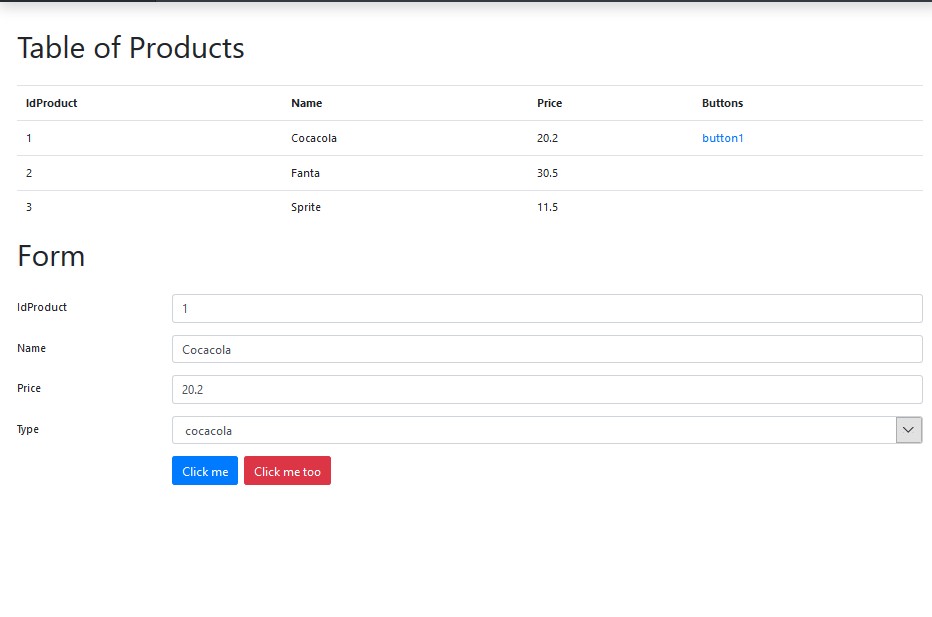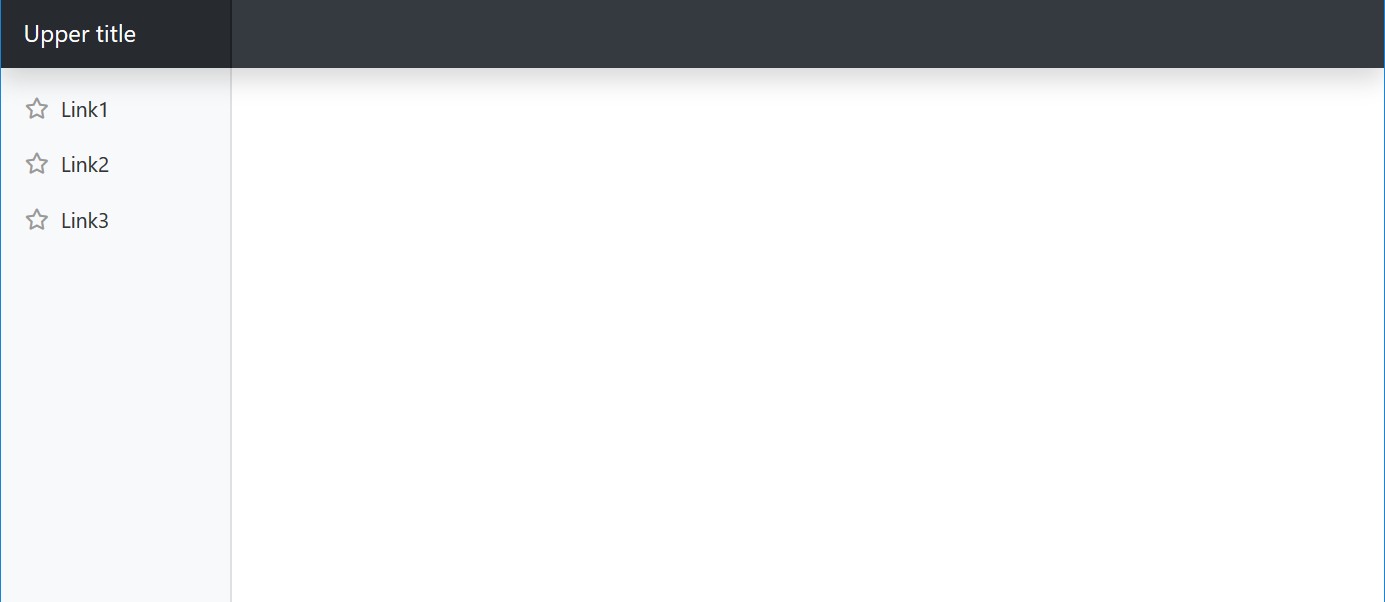eftec / dashone
A fast UI Dashboard generator for PHP
Installs: 801
Dependents: 0
Suggesters: 0
Security: 0
Stars: 6
Watchers: 2
Forks: 1
Open Issues: 0
pkg:composer/eftec/dashone
Requires
- php: >=5.6
- ext-json: *
- ext-openssl: *
Requires (Dev)
- phpunit/phpunit: ^5.7
README
A minimalist dashboard /backend library for PHP
This library allows to create a fast dashboard with the basic features without any template and only using code. In the examples, we create a page for a dashboard in less than 80 lines of code ( examples/test.php )
Example ( examples/test.php ):
Another example ( examples/test.php ):
Getting started
Install via composer
composer require eftec/dashone
Create a new object DashOne (you will need to add the required include, via autoload.php or manually)
$dash=new DashOne();
And you could render a page using the object of the class DashOne()
use eftec\DashOne\DashOne; $dash=new DashOne(); $dash->head('Example - test 1'); // it is required $dash->rawHtml('hello world'); $dash->footer(); // it is required $dash->render(); // it renders an empty page
Classes
DashOne
It is the main class that generates the dashboard.
$dash=new DashOne();
It is possible to add new elements using fluent interface (chain methods each one).
Example: It renders an empty page
use eftec\DashOne\DashOne; $dash=new DashOne(); $dash->head('Example - test 1'); $dash->footer(); $dash->render();
Example using fluent
use eftec\DashOne\DashOne; $dash=new DashOne(); $dash->head('Example - test 1') ->footer() ->render();
Where the method head is required to render the < head > of the page.
The footer is also required to close all the tags.
And every chain of methods must end with the method render() (it draw the page).
// see examples/testuibasic.php $dash=new DashOne(); $dash->head('Example - test 1') ->menuUpper(['Upper title']) ->startcontent() ->menu($links) // left menu ->startmain() // here it goes the content ->endmain() ->endcontent() ->footer() ->render();
Method DashOne->head($title,$extrahtml)
It renders the head of the page. This element is required
$dash->head('Example - test 1');
Method DashOne->menuUpper($leftControls=[],$rightControls=[])
It renders the upper menu of the dashboard.
$dash->menuUpper([new ImageOne('https://via.placeholder.com/32x32')," - ",new LinkOne('Cocacola','#')]);
AlertOne
It renders an alert
new AlertOne($title,$content,$class);
Example:
$dash->alert("It is an alert","Content of the alert")
$dash->alert("It is an alert","Content of the alert","alert alert-danger")
ButtonOne
It renders a button
new ButtonOne('button1','Click me','btn btn-primary');
You could use the method buttons (DashOne) to render a button (or buttons). The method has a second argument to determine if the buttons must be aligned or not with the form.
$buttons=[ new ButtonOne('button1','Click me','btn btn-primary'), new ButtonOne('button2','Click me too','btn btn-danger') ]; $dash->buttons($buttons,false) // where if true then buttons are aligned with the form
$dash->buttons($buttons,true)
$dash->buttons($buttons,false)
ContainerOne
It renders a container where it is possible to add other elements (such as buttons)
new ContainerOne($html);
Example:
$dash->container("<div class='form-group row'><div class='col-sm-10 offset-sm-2'>%control</div></div>") ->buttons($buttons)
The method container() but be followed by a visual method. This method is added inside the container (where it says %control)
Another example:
$dash->container("<hr>%control<hr>")->rawHtml("hello world")
FormOne
It renders a form. It requires a declarative array.
If it sets a definition, then it uses the definition to define the types of input objects (textbox,textarea,etc.)
If a field of the definition has an array then it is used to render a dropdownitem
If it doesn't have a definition then, it uses the values to define the types of input objects (textboxes,textareas,etc.)
You could also render a message (for example for warning or information) You could draw a form using an associative array. By default, every field will be a textbox
$currentValue=['IdProduct'=>"2" ,'Name'=>"aaa" ,'Price'=>"333" ,'Type'=>1 ,'Description'=>'']; $dash->form($currentValue) // it's macro of new FormOne()
Or you could explicit the type of field
$definition=['IdProduct'=>'hidden' ,'Name'=>'text' ,'Price'=>'text' ,'Type'=>['cocacola','fanta','sprite'] ,'Description'=>'textarea']; $currentValue=['IdProduct'=>"2" ,'Name'=>"aaa" ,'Price'=>"333" ,'Type'=>1 ,'Description'=>'']; $dash->form($currentValue,$definition) // it's macro of new FormOne()
UlOne
It draws a list (unsorted list)
$valueUL=['Cocacola','Fanta','Sprite']; $dash->ul($valueUL) // it's macro of new UlOne()
ImageOne
It draws a image
new ImageOne('https://via.placeholder.com/32x32');
LinkOne
It draws a hyperlink
The first value is the name of the link, the second is the address. And the third value (optional), it's a icon (using the classes of Font-Awesome)
new LinkOne('Cocacola','#','far fa-star') $dash->link('Cocacola','#','far fa-star')
TableOne
it renders a table.
$values= [ ['IdProduct'=>1,'Name'=>'Cocacola','Price'=>"20.2"], ['IdProduct'=>2,'Name'=>'Fanta','Price'=>"30.5"], ['IdProduct'=>3,'Name'=>'Sprite','Price'=>"11.5"], ]; $dash->table($values)->... // it must be called after the render
A basic page :
Any pages requires at least to call the head(), footer() and Render().
Render() draws the page so it must be called at the end of the chain.
For example, a basic page is as follow:
$dash=new DashOne(); $dash->head('Example - test 1'); $dash->footer(); $dash->render();
An empty dashboard:
$dash=new DashOne(); $dash->head('Example - test 1'); $dash->menuUpper([new ImageOne('https://via.placeholder.com/32x32')," - ",new LinkOne('Cocacola','#')]); $dash ->startcontent() // start the container ->menu($links) // left menu ->startmain() // start the main container ->title('Table of Products') ->endmain() ->endcontent(); $dash->footer(); $dash->render();
Login Page
The library has a build-in login page that it relies on PHP's session variable.
To use a the function, the session must be enabled
@session_start(); // or via php.ini
And we could read the current session as follow:
$_SESSION['user']; // array(5) { ["username"]=> "" ["password"]=> "" ["remember"]=> "" ["_csrf"]=> "" ["result"]=> bool(true) }
Step 1 Initialize Login Page
To create a login page, you must initialize in the constructor as follow
Using an array (user and password)
$dash=new DashOne(false,true,'salt_123',['user'=>'john','password'=>'doe']);
Or using a method
$validateLogin= function($user) { // this method could access to the database return $user['username'] === 'john' && $user['password'] === 'doe'; }; $dash=new DashOne(false,false,'salt_123',$validateLogin);
Step 2 Fetch values
$user=[]; $dash->fetchLogin($user); // user could returns [ ["username"]=> "" ["password"]=> "" ["remember"]=> "" ["_csrf"]=> "" ["result"]=> bool(true) ]
Step 3 Redirect if the user has sign-in correctly
if($user['result']) { @session_write_close(); header('location:testlogin2.php'); die(1); } else { $message='user or password incorrect'; }
Step 4 Display Login Screen
$dash->head('Example - test 1','',true) // title of the page, extra content in the header and true= for login page ->login($user,null,'Sign-In') // user variable, null or link to the login image and title of the login page ->alert($message) // (optional) shows an alert inside the login page ->footer() // (optional) shows a footer inside the login ->endLogin() // end login container ->render();
Step 5 Log out
The validation of the user is keep in the session. So to close a session we could destroy the session or unsetting the session.
session_destroy(); unset($_SESSION['user']);
Step 6 CSRF protection (optional)
It is possible to add an extra layer of protection by adding the next line
if (!$dash->checkCSRF()) { die(1); }
Step 7 Validating the session
It is possible to validate the session
if (isset($_SESSION['user']) ) { // user has sign-in } else { // user hasn't sign-in }
Version
- 1.7 2020-04-23
- Added .gitattribute Examples and doc are not pushed via composer (it should reduce the size)
- 1.6.2 2020-04-23
- Fix: cleanups.
- 1.6.1 2020-03-03
- Fix: TableOne now allows non-base zero array
- 1.6 2020-18-01
- modified LinkOne::LinkOne()
- added summernote to textarea
- 1.5 2020-16-01
- new method getLogin()
- new method logout()
- 1.4 2020-16-01
- new method cssLogin()
- new method login()
- new method fetchLogin()
- new method decrypt()
- new method encrypt()
- new field var $salt='';
- new field $validateLogin (callable)
- changes to __construct()
- 1.3 2020-01-15 new method fetchvalue()
- 1.2 2019-03-30 New changes.
- 1.1 2019-03-17 Fixed some bugs
- 1.0 2019-03-01 First Version.
Copyright
Copyright Jorge Patricio Castro Castillo Dual License (LGPL v3 and Commercial License)
You could use in commercial / close source product or service while
In a nutshell (it is the license):
- You must keep the copyright notices.
- If you modify the library then you must share the changes and modifications.














